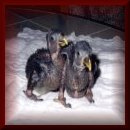ECLECTUS

ECLECTUS
Physical Description
The male and female Eclectus are very different looking. The male Eclectus are green with a yellowish beak, while the females are a red color with a black beak. Underside of male's wing is bright red with a small patch of blue.
The red-sided and the vosmaeri are two of the Eclectus sub species most commonly bred in the U.S. The vosmaeri is the larger of the two, with the male being the typical green with red markings and a large coral colored beak. The hen shades from red to lavender, with yellow at the vent and tip of the tail. The head seems rather small for the size of the body. The red-sided hen has a narrow blue eye ring and a very brilliant red head, neck, and upper chest - with a distinct change to brilliant blue below. They seem to have larger, blockier heads than the vosmaeri, and slightly more compact bodies. Beak and feet on the hen are black.
Health note: These parrots have unusually long digestive tracts; to remain healthy they require large amounts of fiber in their daily diet. Also - they require a variety of fruits.
Length:
14 Inches
Origin:
New Guinea and North Australia.
Trainability:
These birds can be taught to talk, and will sometimes imitate humans very well.
Loudness:
These birds are quiet and, next to the Greys, they are the best talkers.

MY NEWEST BABIES

THESE ARE ECLECTUS BABIES ABOUT SEVEN WEEKS OLD. THE MALE IS GREEN, THE FEMALE IS OF COURSE MAUVE ON WINGS AND BACK, WITH RED HEAD. OTHER COLORS WILL APPEAR AS THEY GET OLDER. SUCH AS BLUE ON TIPS OF THE WING AND YELLOW ON TIP OF THE TALE. THIS WOULD BE FOR THE FEMALE. THE MALE WILL BE A VERY BRILLANT GREEN, WITH RED AND BLACK UNDER THE WINGS. AND A LITTLE BLUE ON THE SHOULDER (SOMETIMES)

These guys are about ten weeks old, as you can see, they still have more feather to get.


These are Eclectus Parotts, the red one is a female, the green one is the male. About eleven weeks old. These are the next best talkers to the African Gray. They love attention and are usually friendly with everyone, depending on the conditions they are surrounded by. These are one of my favorite birds.




These are 12 week old babies. Still on two hand feedings a day.
However, they are starting on seed and drinking water and ready for fruits and vegetables.
Ecelectus parrots: the boy is green and the girl is red and blue also purple.
Blue & Gold Macaws. and a Moluccan cockatoo.
ECLECTUS-Green Bird in Front (12 weeks)

These little guys are SALAMON ISLAND ECLECTUS each about 4 weeks old. Both are males. They are born covered with dark or light down. The male has darker down and the female has lighter down. Because the colors are so close when they are first born, you have to wait at least three weeks to tell the difference between the males and the females.


OR PHONE JEAN AT: (909)687-1031